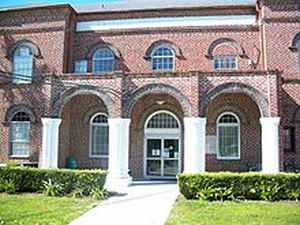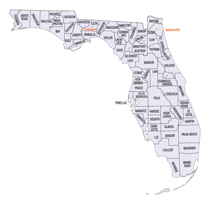Florida Counties
There are sixty-seven counties in the state of Florida. In 1821, there were only two Counties in Florida: Escambia to the west and St. Johns to the east. From these two Counties were formed 67 today. Its last county was created in 1925 with the formation of Gilchrist County from a segment of Alachua County.Gilchrist County, Florida
Gilchrist County Education, Geography, and History
Gilchrist County is a rural county located in the state of Florida. Based on the 2010 census, the population was 16,939. Gilchrist County was created on December 4, 1925 from Alachua County. The county seat is Trenton, Florida. This county is named for Albert W. Gilchrist (1858-1926), the 20th Governor of Florida.
Gilchrist County is included in the Gainesville, FL Metropolitan Statistical Area.
Etymology - Origin of Gilchrist County Name
The county is named for Albert W. Gilchrist, governor, the 20th Governor of Florida, 1909-1913.
Demographics:
County QuickFacts: CensusBureau Quick Facts
Gilchrist County History
Gilchrist County was established in 1925 and is the last county in Florida chartered by the state legislature.
The popular story of how Gilchrist County came into being concerns a bluff by citizens in the western part of
Alachua County. The citizens there in what was called "The West End" wanted a road from the Suwannee River at
Fanning to Gainesville, the county seat of Alachua County. When the County Commission refused to build the road,
the citizens in the western part drew up plans for a new county and presented it to the Alachua County Commission.
When the County Commission still refused to build the road, the citizens had to save face, so they sent a petition
that would create a new county to the Legislature, meeting then in a special session in Tallahassee. The bill passed
and was signed by Governor John W. Martin on December 4, 1925. As a result, there came into being Florida's
sixty-seventh county, the last and smallest Florida county.
There were other reasons for the establishment of Gilchrist County, including the issue of the no-fence law and the
distribution of racetrack money.
Alachua County favored a no-fence law, a law that would fence in cows and prevent them from wandering at large; many
people in the Western End did not like such a law. Also, many citizens in the western part of Alachua County felt
that they were not adequately represented on the Alachua County Commission. In 1925, for example, that Commission
wanted to bridge over the Suwannee River at Fort Fannin to go unattended; the Commission felt that it was just too
expensive to keep a bridge tender there.
The people in the West End felt neglected by the Alachua County Commission, a feeling partly brought on by the
distances involved. It would take all day, especially on the sandy roads before the roads were paved, to make the
trip to Gainesville and back in a Model-T to do any official business with the school superintendent or the sheriff,
whose offices were in the courthouse in Gainesville.
Many people in the West End believed they would be better off financially, especially because a new county would
receive an equal share of the state's racetrack revenue, which the state distributed equally to each county.
The citizen group had chosen the name Melon County as its name to honor the many watermelons grown in the area, and
at first it seemed to be a good idea.
Concerning the mane of the new county, the Legislature had its own ideas. Legislators first suggested the name
Wilson to honor the late President Woodrow Wilson, but then decided to name the new county after ex-Governor Albert
Waller Gilchrist, who was ill at the time in a New York hospital.
Gov. Gilchrist finally died of cancer on May 15, 1926, and was laid to rest in Punta Gorda, north of Fort Myers.
While most of his estate of a half-million dollars went to charities, his will also stipulated that part of it be
set aside to provide the children of his beloved Punta Gorda with ice cream every Halloween because, in his words,
"It costs but little and affords much happiness." His name was a fitting choice for the new County.
On December 4, 1925, Governor John W. Martin signed the law creating Gilchrist County. On January 1, 1926, Gilchrist
County came into existence, the law county to be established in Florida. it consisted of 339 square miles or 226,560
acres, most of which was farmland or timberland.
Geography: Land and Water
As reported by the Census Bureau, the county has a total area of 355 square miles (921 km2), of which, 349 square miles (904 km2) of it is land and 7 square miles (17 km2) of it (1.85%) is water.
Gilchrist county is located close to the center of Florida. The
county has clear natural springs,rivers and beautiful nature trails.
Gilchrist county has one recreational park, Hart Springs.
Neighboring Counties
Bordering counties are as follows:
- Northeast: Columbia County
- East: Alachua County
- South: Levy County
- Southwest: Dixie County
- Northwest: Lafayette County; Suwannee County
Education







